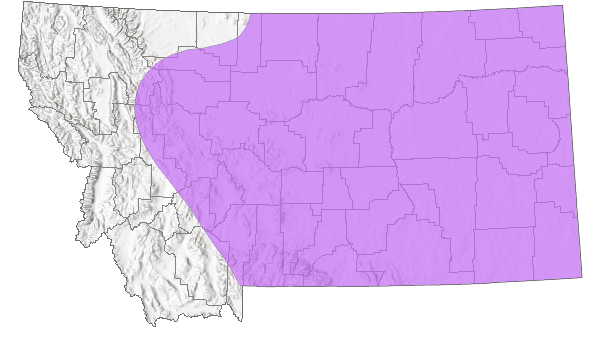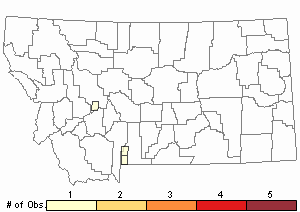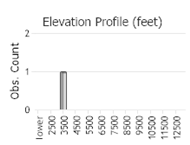View in other NatureServe Network Field Guides
NatureServe
Montana
Utah
Wyoming
Idaho
Wisconsin
British Columbia
South Carolina
Yukon
California
New York
Geyser Grasshopper - Trimerotropis diversellus
General Description
The following is taken from Hebard (1928), Otte (1984), Vickery and Kevan (1985), and Scott (2010). The general body color is dark grayish brown and can sometimes be reddish. Specimens in higher elevations tend to be darker than those in the lowlands. The median carina of the pronotum (thorax) is obvious and bluntly bilobed, with the anterior lobe being higher and longer. The tegmina (forewings) is dark banded, separated by light bands. The hind wing disk is sulfur yellow, sometimes with a pale greenish tinge and the black crossband is broad across the mid-region, narrowing toward the anterior edge, with a short, thick spur. The outer face of the hind femur is brownish. The inner face is pale to buff with a black median area, apical black ring, and knee. The hind tibia is yellowish to buff tinged with brown, and always with a lighter grayish ring at its base.
Communicative behavior/Crepitation*
Little has been reported in the literature, however Otte (1984), describes the following for this species, based only on California observations: “As males approach females, they produce widely and irregularly spaced pulses of stridulation*, using single strokes of the hind femora. These are interspersed with bursts of femur-shaking, one leg at a time.”
*Crepitation is the sound produced by grasshoppers making a clicking or snapping noise with their wings when in flight, during courtship, territorial encounters or being disturbed.
*Stridulation is rubbing one body part against another, usually the hind femur against the forewing in the case of the Band-winged Grasshoppers. This is often used for attracting a female during courtship (Otte 1970).
Phenology
This species overwinters in the egg stage. Nymph hatching dates are unknown. Adults are present from July to October (Otte 1984, Vickery and Kevan 1985, and Scott 2010).
Diagnostic Characteristics
The following comes from Hebard (1928), Otte (1984), Vickery and Kevan (1985), and Scott (2010). The body length to tip of forewings for males is 25-35 mm, and 30-45 mm for females.
The Geyser Grasshopper is easily confused and difficult to identify from the
Pallid-winged Grasshopper (
Trimerotropis pallidipennis). Currently, in Montana, identification can be relatively certain by geographic range.
Pallid-winged Grasshopper (
T. pallidipennis) has been reported for only 3 southwestern counties (and possibly concentrated in that area), whereas
T. diversellus is more widespread (compare range maps). Habitat type is also an indicator to note. Taxonomic morphological differences relative to the dorsal crest shapes of both species are well illustrated in Otte (1984). He also notes that the forewing (FW) and hind femur (HF) lengths for
T. diversellus is shorter (measuring 1.85 mm FW/2.09 mm HF) than that of
T. pallidipennis (2.08 mm FW/2.35 mm HF).
Species Range
Montana Range
Range Descriptions

 Native
Native
Range Comments
The Geyser Grasshopper occurs in British Columbia, Alberta, and Manitoba, southward to California. From the Pacific Coast states, extending eastward to western Minnesota, the Dakotas, and Wyoming. In Montana, it has been reported for 10 counties (Hebard 1928, Otte 1984, Vickery and Kevan 1985, and Scott 2010).
Observations in Montana Natural Heritage Program Database
Number of Observations: 4
(Click on the following maps and charts to see full sized version)
Map Help and Descriptions
Relative Density

Recency



 (Observations spanning multiple months or years are excluded from time charts)
(Observations spanning multiple months or years are excluded from time charts)
Habitat
This species inhabits grasslands, alkaline depressions, and open pine woodlands up to about 7,500 feet (Otte 1984).
Food Habits
Unknown.
Reproductive Characteristics
Unknown.
Stewardship Responsibility
References
- Literature Cited AboveLegend:
 View Online Publication
View Online Publication Hebard, M. 1928. The Orthoptera of Montana. Proceedings of the Academy of Natural Sciences of Philadelphia, Vol. 80:211-306.
Hebard, M. 1928. The Orthoptera of Montana. Proceedings of the Academy of Natural Sciences of Philadelphia, Vol. 80:211-306. Otte, Daniel. 1970. A comparative study of communicative behavior in grasshoppers. Miscellaneous Publications, Museum of Zoology, No. 141. Ann Arbor, MI: University of Michigan.
Otte, Daniel. 1970. A comparative study of communicative behavior in grasshoppers. Miscellaneous Publications, Museum of Zoology, No. 141. Ann Arbor, MI: University of Michigan. Otte, Daniel. 1984. The North American Grasshoppers Volume II. Acrididae (Oedipodinae). Harvard University Press. 366 pp.
Otte, Daniel. 1984. The North American Grasshoppers Volume II. Acrididae (Oedipodinae). Harvard University Press. 366 pp. Scott, R.D. 2010. Montana Grasshoppers, Katydids, and Crickets A Pictorial Field Guide to the Orthoptera. MagpieMTGraphics, Billings, MT.
Scott, R.D. 2010. Montana Grasshoppers, Katydids, and Crickets A Pictorial Field Guide to the Orthoptera. MagpieMTGraphics, Billings, MT. Vickery, V. R. and D. K. M. Kevan. 1985. The grasshopper, crickets, and related insects of Canada and adjacent regions. Biosystematics Research Institute, Ottawa, Ontario. Publication Number 1777. 918 pp.
Vickery, V. R. and D. K. M. Kevan. 1985. The grasshopper, crickets, and related insects of Canada and adjacent regions. Biosystematics Research Institute, Ottawa, Ontario. Publication Number 1777. 918 pp.
- Additional ReferencesLegend:
 View Online Publication
View Online Publication
Do you know of a citation we're missing? Capinera, J.L., R.D. Scott, and T.J. Walker. 2004. Field Guide to Grasshoppers, Katydids, and Crickets of the United States. Ithaca, NY. Cornell University Press.
Capinera, J.L., R.D. Scott, and T.J. Walker. 2004. Field Guide to Grasshoppers, Katydids, and Crickets of the United States. Ithaca, NY. Cornell University Press. Sater, S. 2022. The insects of Sevenmile Creek, a pictorial guide to their diversity and ecology. Undergraduate Thesis. Helena, MT: Carroll College. 242 p.
Sater, S. 2022. The insects of Sevenmile Creek, a pictorial guide to their diversity and ecology. Undergraduate Thesis. Helena, MT: Carroll College. 242 p.
- Web Search Engines for Articles on "Geyser Grasshopper"
- Additional Sources of Information Related to "Insects"





